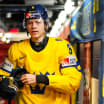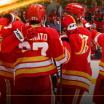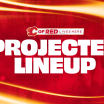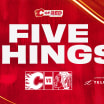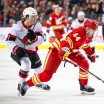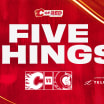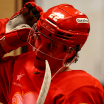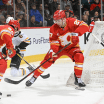The second period is a go. Inside the coaching bunker a man sits at a desk, alone in the room, absorbed in the action flickering across the screen.
"Welcome,'' Jamie Pringle jokes, lifting his eyes for only a moment, "to the dungeon."
FLAMES EXTRA - VIDEO GAMES
Jamie Pringle is the video guru for the Flames and talks about the important role it plays in today's NHL
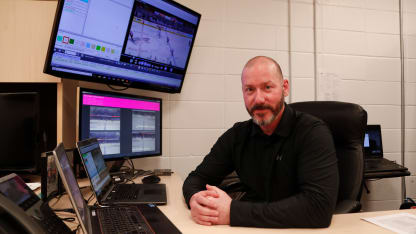
By
GEORGE JOHNSON @GJohnsonFlames / calgaryflames.com
On his desk, directly facing him, a pair TV monitors, the higher one larger. Three laptops are interspaced around the desk.
Meanwhile the play of the game unfolds through two sets of doors, down the hallway and on the bench/ice area in front of 19,021.
The gaze of the man seated at the desk is laser focused on his screens.
Now deep into his seventh season as video coach for the Flames, Pringle's job is to pick out trends and tendencies, find clips and examples, seek out possible advantages.
Around the 31-team league these days, secrets are virtually non-existent. Everyone knows everyone else's business.
"There's someone on every team doing my job now,'' says Pringle, (nicknamed 'Chips', for obvious deep-friend potato snack ties). "Everyone's dissecting games, providing information for players, coaches and staff.
"I'd say on average scoring chances are about 14 aside per game, so if you're able to minimize, say, three off the opposition and maybe add two or three of your own, work the ledger that way …
"You're trying to give players a road map, not overload them. We prep a lot in here but you don't want to give so much information that it takes away from their natural instincts.
"That's my biggest no-no. The overload.
"The last thing you want them to be is robotic. As I said, we just want to give them a road map - 'Hey, here's what you're going to see.' Playing every other night, teams are going to throw different looks at you. You might get through the neutral zone one way last night, tonight we're going a different route.
"We're not adjusting our game, per se, but we will tweak things to help the players.
"They have to play with their natural instincts. So we just want to make their lives as easy as we can, to help them go out on the ice and have success."

Different games, new sets of puzzles, are on top of you in a blur across today's NHL.
"In this job, I find you get into a rhythm,'' says Pringle, married with two children. "The games come at you so fast. I like that. I like games. I like the up and down, preparing every other night then playing every other night.
"So I prefer the schedule in the NHL in comparison to, say, junior.
"It goes by … fast.
"You start the season and all of a sudden you're at Game 62. It's crazy.
"Go, go, go.
"At the end of the year, though, you do get a couple weeks to just crash. And for those two weeks you don't want to open your laptop."
On a typical game day at Scotiabank Saddledome, Pringle arrives around 6:30 a.m., the coaches agenda beginning their day with powerplay prep.
"We rotate our 5-on-5 pre-scout within the coaches here so I've got a certain set of teams. That goes around the team. If we're playing one of those teams that night, I'll just be finalizing what I want to show.
"Usually you watch their last two or three games. We're deep into the season now, you've played everyone, so it's a case of going back and pulling things from our games against the team you're facing."
A half-hour meeting immediately before heading out for the typical 10:30 a.m. morning skate, with bench boss Glen Gulutzan going over film from the most recent game, then maybe a motivational video.
"Sixty-some games into the year, you need a change-up sometimes,'' says Pringle. "We try to keep it fresh. You don't want to be going in there throwing only Xs and Os at them.
"Gully's really good at that."
Following the skate, a pre-scout gathering to discuss tendencies, loading up IPads with data on face-off tendencies, opposition goalie tendencies, etc., etc.
"Then go home, have a couple hours just to chill out and throw on the suit."
Back to the rink late afternoon for PK and 5-on-5 meetings, followed by perhaps a quick video peek at the team the Flames are either playing that evening or a coming opponent.
Then, it's showtime, folks.
"When I came into the league (with Florida) in '07 you still had a lot of old-school type players,'' Pringle recalls. "We had (video) available but it really wasn't being used much. You'd get that look, you know?
"Those guys came from a different environment, a different way of thinking. I'd say when I joined Hockey Canada, that's when I started noticing that age-group, the world junior group, Jonathan Toews and those guys, warmed up a lot more to video.
"Really, every year more and more players are wanting to have it. The age group arriving now, they're visual learners; can comprehend a lot of information. They're on their gadgets all the time. This is just an extension of that."
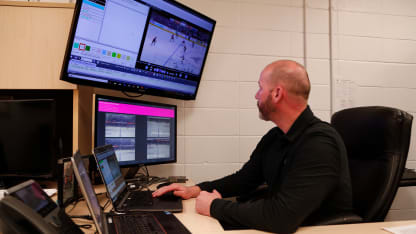
One of the new tasks for teams are the critical matter of coaching challenges. Pringle, from the coaching control room, communicates with assistant coach Dave Cameron on the bench.
"We've got the Hawkeye in place, so we have access to all the blueline cameras, all the overhead cameras. You're recording your own game but also looking at every blueline play that's close.
"You've got to be on top of it right away. We had one of the other night - Mony scores, skate's two inches off the line. Those are the way the rules are being called.
"The play could be going on for two minutes in the zone but I need to know. You've got 15 seconds to challenge so I've got to stay on top of that. The good news is we've got the bench monitors now, so Gully can have a look, and I have radio communication with Dave.
"Especially with goalie interference. Depending on the time of game, we talk that through.
"The blueline ones for me are yes or no: Challenge or don't. But the goalie interference is really … murky. So we have multiple eyes on it, they're seeing what I am at their feet on the bench, and we talk it through.
"You've got to be 100 percent certain. You're seeing plays that are half an inch and you've got to make the call on it."
Pringle's entry into the video side of coaching began during his assistant coaching days in Belleville of the OHL, back in 2000. A component of his duties there entailed breaking down film.
Following his days with the Bulls and then with the Kingston Frontenacs, a position at Hockey Canada opened up on the technical side, encompassing all the national teams, from world championships to world juniors.
"To be air-dropped into a different coaching staff every six weeks to see what makes them tick was invaluable. That's the reason I'm here. Brent Sutter, I'd worked with him with the world junior program. Pete DeBoer in Florida, I'd worked with him with the juniors, too.
"That's kind of the way it unfolded.
"There's still a hockey component for me. I'm a coach. That's my first passion. I've learned the technological side but I've never lost that passion for coaching.
"I like to think I'm a pretty laid-back guy. So I think it's pretty easy to come to me and know they can talk to me. I pride myself on that.
"Players need to decompress at times. This is our bubble.
"Trust in this game is big.
"Even though I'm not on the bench I know I can still assist the players positively and you still get a good feeling coming out of a game knowing they've executed the game plan. That's one thing about our group - they're good at paying attention to detail."
The explosion of technological advancement and innovations shows no signs of abating.
"Not so long ago, we were still in the old VCR-to-VCR days,'' he reminds you.
"In Florida, I remember having these big bricks, these big hard-drives. Now you can take an SD card, 100 gigs. Storage, what you can carry around is just insane now. And keeps changing every year."
So where does it all evolve from here, from now?
"Hard to say,'' is the frank, amused reply. "I don't know if we'll ever get to the point where there are holograms coming out in the middle of the dressing room.
"Sitting around, 20 guys with goggles on, using virtual reality.
"I try to stay on top of things as best I can but to try and predict where it'll go, where it'll end up …
"But there'll be something. That much you can count on."

